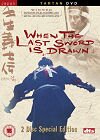|
Mini Review
|
|
|
| Director |
|
Yojiro Takita
|
| Cast |
|
Kiichi Nakai
Koichi Sato
Miki Nakatani
Yui Natsukawa
Yuji Miyake
|
| Distributor |
Tartan Video
|
| Running Time |
137 Minutes
|
| Certification |
|
15
|
|
Reviewed By
|
|
Stuart Crawford
|
|
Buy this film
|
|
|
|
|
|
|
WHEN THE LAST SWORD IS DRAWN (2003)
|
I used to hate subtitled films. Any film that you had to follow by reading those annoying words at the bottom of the screen I didn’t give the time of day too. I mean, how could you enjoy the action when you had to spend all of your time not looking at it? But I grew and evolved and slowly came to understand that you could actually read the words and watch the action and, dare I say it, enjoy the film. And I’m glad I did because if I hadn’t, then I would have taken the DVD from Vaughan and, after looking at the back of the box and realising that there was no English language version of the film, politely handed it back. And that, quite simply, would have been a mistake.
When the Last Sword is Draw is a Samurai film and a very good one at that. The story revolves around one man – Kanichiro Yoshimura, a lone Samurai whose purpose in life was to make enough money to support his family. The tale is told some years after his death by his grandson, recounting the stories told him by his father, and by a man who knew Kanichiro well, a fellow Samurai called Saito.
The film shows Kanichiro finding a wife, having children and leaving his clan so that he can find well paid work in this time of famine and poverty and send any money home to his family. His fellow warriors initially see him as dishonorable for this mercenary approach and Saito is one of the main figures that holds him in contempt for his actions. However, he and Saito end up in the Shinsengumi, the guardians of the Imperial capital, and have to defend themselves and the clan from the far superior government troops when civil war breaks out. Here Kanichiro shows himself as a master swordsman time after time and the hatred that Saito felt turns to friendship.
This is not a flashy big budget movie with lots of CGI bells and whistles. Where The Last Samurai at times used massive sets and lashings of extras, this film is a lot smaller, quieter and focuses more intensely on the character story. That’s not to say that there isn’t any action. There are a few fights on quite a small scale that usually involve more than two protagonists. They are done incredibly well but are realistic so you don’t get your Crouching Tiger Hidden Dragon moments, which are enjoyable but are so desperately not what this film is about. There is a little CGI involvement (I hope to God that the decapitation scene was) but it is used to near perfect levels and absolutely does not detract from the film. The soundtrack, again, is so understated that it fits the character of the film brilliantly and adds to an already winning recipe.
I think this is going to be one of those films that I am going to enjoy more and more as I watch it again and again. The sets and costumes were fantastic, the acting was excellent (I can see why it won the awards that it did) and the story was engaging. I strongly recommend that if you have the chance, and you enjoy this sort of thing, that you take the time to watch and absorb a brilliant piece of film making.
Tartan's release is a fan-fair occasion with a great dual disk set being offered to the punters. The first disk holds the main feature complete with a pretty solid 1.85:1 anamorphic aspect ratio and a crisp Dolby Digital and DTS 5.1 soundtrack. On the second DVD you can find the extras, and what you get is worth the extra disk. There are five behind the scenes featurettes (I especially enjoyed the Sword Practice one) that show you what life is like behind the camera on a Japanese film set. There are also a dozen or so cast and crew interviews, some footage from the movie premier and some more from a press conference. All in all a very good package.
|
|
Score
|
|
8 / 10
|
|
|





